When and how onions are harvested in the northwest: recommendations for digging in different regions of Russia
Although it seems that the climate of the Leningrad or Arkhangelsk regions is not at all suitable for growing vegetables, carrots, peas, cabbage and even onions are planted in the fields and gardens. The weather in this region does not please with a large number of sunny days, high temperatures, warm nights. It happens that by the end of summer it does not stop raining, and the maturity of crops is postponed. When it is time to harvest onions in the northwest, you can understand by paying attention to certain signs. It is important not to miss the moment of full ripening, otherwise the crop harvested at the wrong time will not be stored, but will rot and deteriorate.
Features of harvesting onions in the northwest
A heat-loving culture can be grown in Siberia, and in the Pskov and Vologda regions. But autumn comes to these regions quickly, and despite the fact that in August the sun is still shining and even warming, there is no heat at night, thick fogs appear, and the gap between daytime temperatures is increasing. In the northwest, early varieties of onions are grown, which ripen in 90 days, and medium ones - within 120, later ones do not ripen here.
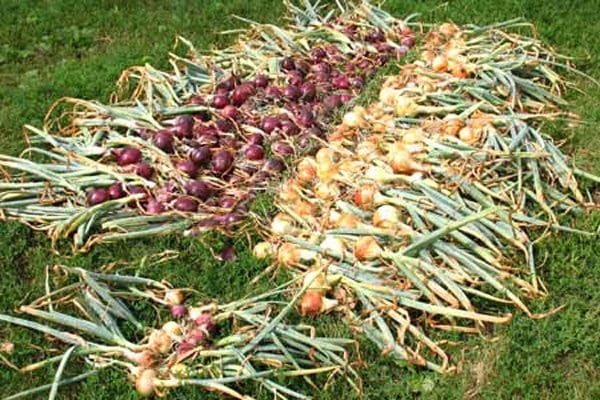
In the Arkhangelsk region
In the northern part of the region, which has a significant territory, vegetables are planted somewhat later than in the south, and the timing of harvesting is also different. In open beds in the Arkhangelsk region, even thermophilic tomatoes ripen. Onions are harvested here until mid-August; in a sunny summer, harvesting for the winter begins in the last decade of July. The work is in a hurry to complete before the onset of rains.
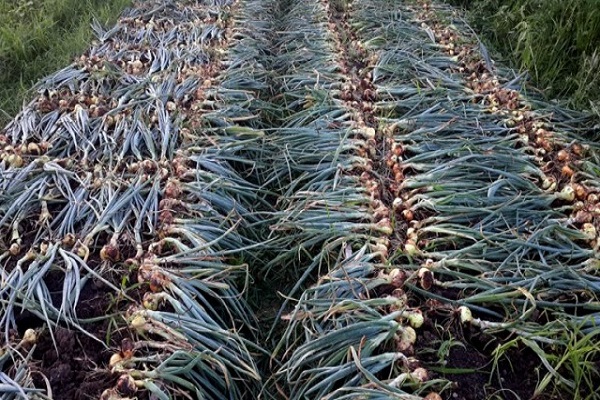
In the Leningrad region
Inhabitants of St. Petersburg and its environs are not happy with summer with an abundance of sun and warmth, high humidity is constantly present. Summer residents in their plots plant onion onions, which are usually harvested in mid-August, but the period is adjusted taking into account:
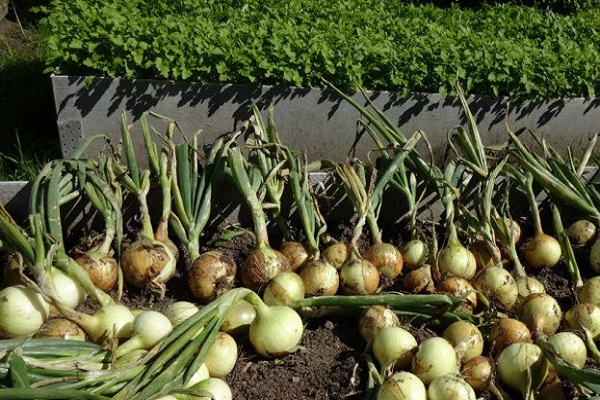
- crop varieties;
- weather conditions;
- external signs;
- location of the site.
Cleaning is carried out on fine days, without waiting for bad weather. Otherwise, it becomes problematic to prepare onions for the winter.
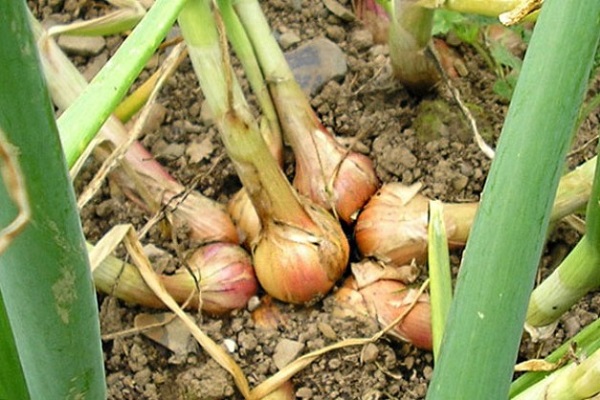
In the Kaliningrad region
Growing crops from seedlings in regions where the summer is short allows you to get a full harvest. In such climatic conditions as the Kaliningrad region, varieties with a long growing season are selected.
The bulbs ripen faster, are well stored, in contrast to growing from seeds, which is possible in the southern regions and in the middle lane.
From the first days, summer residents and gardeners of the Kaliningrad region are trying to harvest until the rains begin. Onions are planted here when the soil warms up to 10 degrees, and this happens in the last days of April - early May. From the third decade of July, when the days are clear, they begin to harvest the bulbs for winter storage.
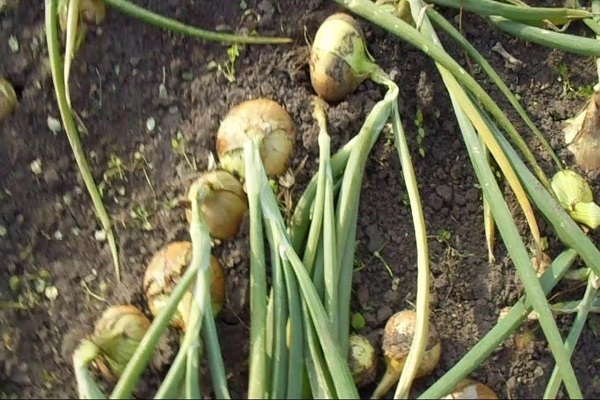
In the Novgorod region
In protected and open ground, vegetable crops are grown on the territory of the Valdai Upland and the Priilmenskaya Lowland, which belong to the Novgorod Region.
At first, summer residents and gardeners plant local varieties from seedlings with bulbs with a diameter of 2 cm, and then use samples, which, in a short summer, provides the best harvest, which begins to dig up from the last days of July. The work is completed by mid-August, although September in the Novgorod region still pleases with warmth, but overripe heads will not be stored.
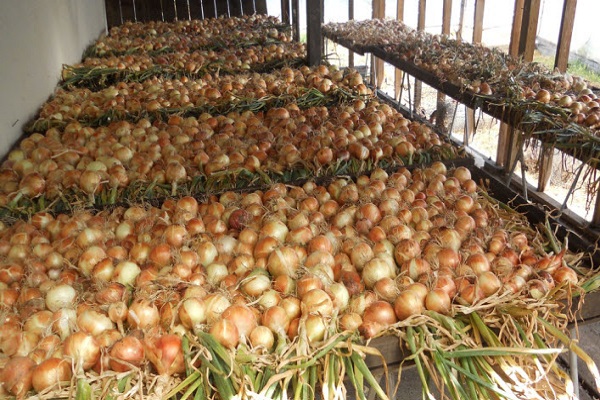
Onion harvesting dates depending on the region
The period when you need to make preparations for the winter depends on the type of culture, the time of planting in the ground, the weather, and the characteristics of care. In the same region, the crop ripens with a difference of up to 2 weeks. In the heat, dry heads ripen earlier.
For the north-west, center, Siberia, the deadline until which it is necessary to remove the onion is the 20th day of August. In most regions, prolonged and cold rains begin after this date. Drying heads for long-term storage becomes difficult.
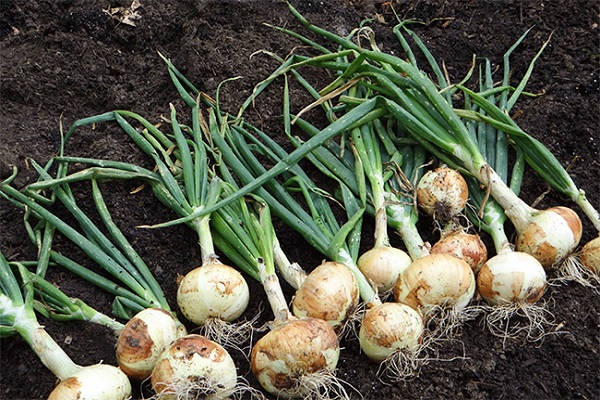
How to determine the ripeness of root crops
It is very important to know exactly when to harvest the crop. The onion must not be allowed to overripe, otherwise:
- The upper scales fall off.
- Roots are formed on the heads.
- The product loses its taste.
- The fetus is affected by disease.
Unripe bulbs quickly rot, since microbes are sent through the juicy neck into them.

It is possible to determine when it is time to harvest by some signs. Chief among them are yellowed and dried feathers. They begin to fall apart and lie down, and the outer scales change color, the neck becomes thinner and dries up. You can calculate the date of digging the bulbs by adding another 65 to 80 days to the planting day.
Preparatory work
Before harvesting a vegetable for long-term storage, you need to use tips that help reduce the number of spoiled heads. 20 days before harvesting, you need to stop loosening the earth, fertilizing with fertilizers. If rainy weather is forecasted, the planting can be covered with plastic. A week before digging out the bulbs, the upper part is cleared of soil.
It is better to remove the heads in the morning and be sure when it is dry. No need to pull them out, you need to pry them off with a shovel or pitchfork. The bulbs are air-dried by placing them on burlap.

How to speed up the ripening process
In the northwest region, it often happens that the time has come to dig up the onions, and the leaves are not even going to lie down. Rains and cold summers prevent heads from ripening.
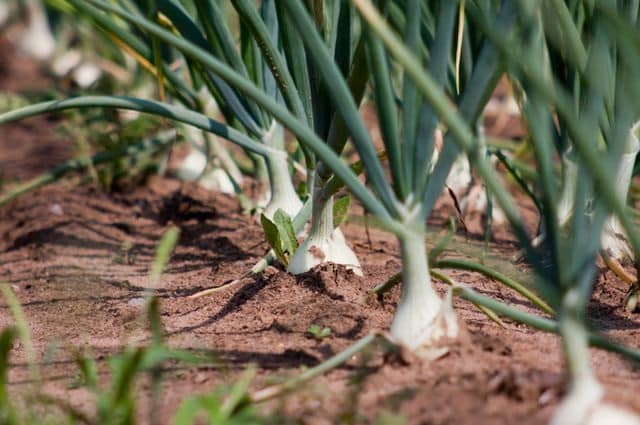
Stopping watering
The outer scales dry out faster in dry weather. To accelerate the ripening of the bulbs 3 weeks before the due date for harvesting, the beds stop watering, which makes it possible to significantly reduce the moisture content of the soil.

Undermining roots
Garden owners resort to some procedures that help speed up the lodging of feathers, the ripening of the vegetable. 15 days before storage:
- Trim the tips of the roots at a depth of 6 cm.
- They dig in the heads, and they stop receiving nutrients from the soil.
- Shake off the soil from the bulbs.
In no case should you mow the feathers when the scales have not yet dried. Through them, bacteria are sent to the fetus, which leads to its decay.
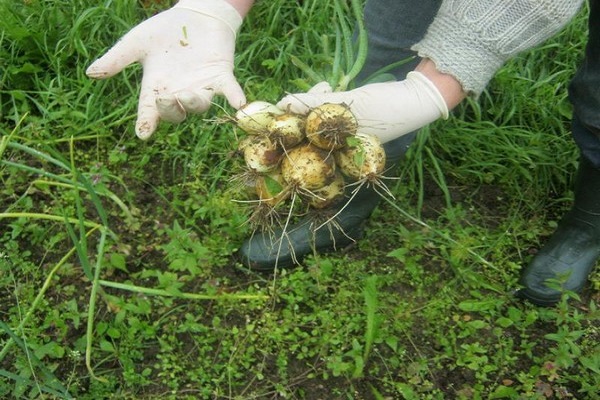
Exposing the bulbs
In the southern regions, vegetables ripen quickly.In the northwestern region, damp, cold weather prevents the scales from drying out and feathers lodging.
To speed up this process, the upper part of the heads is exposed, they cannot get enough nutrition from the ground and they mature.
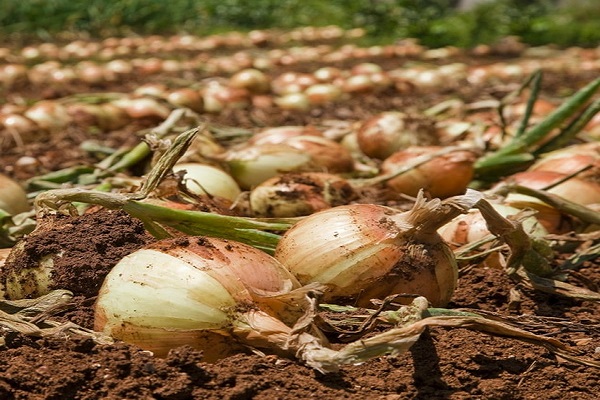
Harvesting
You need to start digging the bulbs out of the soil when more than half of the feathers are covered. In 10 days they will all decay, and during this time it is advisable to completely remove the heads that will have time to ripen.
The cleaning period is also determined by other criteria:
- The onion neck, covered with scales, crunches when pressed.
- The lower leaves wilted.
- Roots died on some root crops.

In loose soil, the bulbs can not be pushed on with a pitchfork or a shovel, but simply pulled by the bunch. They are dug in the clay soil, and the soil is carefully cleaned with hands, and not with tools, so as not to damage the root crop.
The dug out bulbs together with the feather must be dried for at least a week, in clear weather the heads are left in the fresh air for the whole day, and in the evening they are taken to a ventilated shed or veranda.
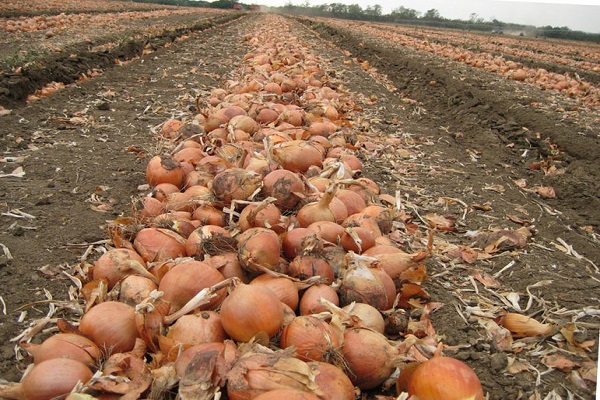
Features of cleaning in rainy weather
In the north-western regions, the sun does not always shine at the end of July, and even more so in August, there are fine days. In this region, you need to be prepared for the fact that the harvest will have to be in wet weather, when it is difficult to determine whether the onions are ripe. To dry the heads selected in the rain, you need to put them in one layer in a warm room that is well ventilated.
Once a day, the bulbs must be turned over; cut or tainted bulbs are selected separately. It is not necessary to clean the earth until the soil begins to crumble by itself. Having folded the heads in wooden boxes, they dry for at least a week. If the bulbs are too dirty, they are washed in water and the scales are removed, which will reappear after three weeks, when the roots dry out in a well-ventilated room.

How to prepare onions for storage
Feathers are not trimmed immediately after harvest. During drying, the heads are turned over at least once a day so that the air enters evenly. After 8 or 10 days, the roots and leaves are removed, the neck is cut off so that up to 5 cm remains.
After another 2 weeks, the bulbs are sorted out, and if the scales are dry and rustle, this means that the vegetable is ready for storage. The heads are transferred to baskets, boxes.
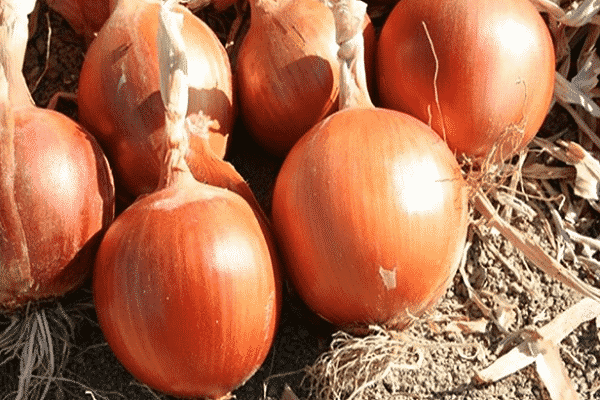
Summer residents and gardeners also collect seeds for the next planting from their beds. To do this, take dense bulbs, the diameter of which is about 10 cm. For three months they are kept in a warm room, they are sent to the ground in April, cutting off the neck. Distance between bulbs 15 cm, a little more between rows. At the end of August, the leaves turn yellow and dry, the seeds ripen.
In a private house, the crop is left in a dry basement or shed. In the apartment, keeping the dried heads is also obtained until next spring. To do this, wreaths or braids are woven, which are tied to the ceiling or wall in the closet or kitchen.
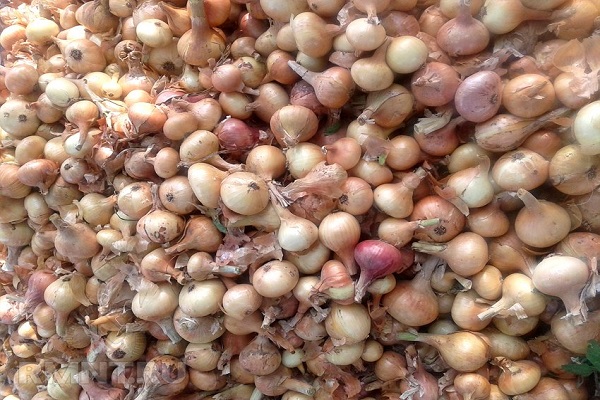
On a warmed balcony or loggia, the bulbs are sent to baskets or wooden boxes, the height of which does not exceed 25 cm, and hung in a stocking or net.
To prevent the harvested crop from rotting, not drying out, it must be stored in a room where the humidity is not lower than 55%, but not higher than 60. The temperature where the turnip is kept for food should be in the range of 20-22, on the feather - at 5 degrees ... Small seedlings, which are planted to obtain fresh herbs, are left indoors, where it is not higher than 5 ºС. To prevent small bulbs from drying out, they are sown for the winter. In the spring, sprouts appear that develop rapidly, young leaves are formed.
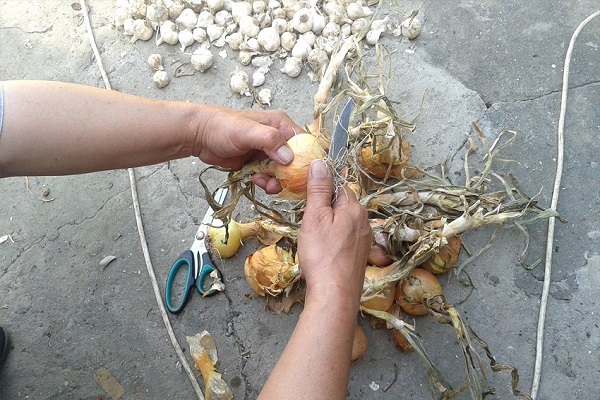
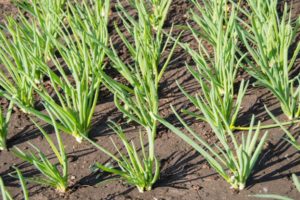

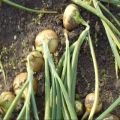

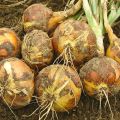

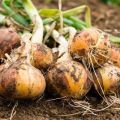
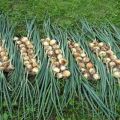

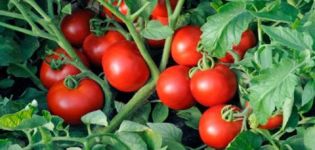
In order to remove something, you also need to grow something, but here I would recommend using BioGrow, this product is a bioactivator of plant growth, you will not regret the decision to use it.